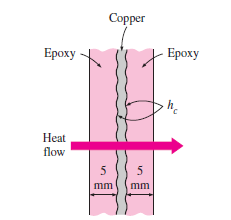A 1-mm-thick copper plate ( k = 386 W / m \cdot{ }^{\circ} C) is sandwiched between two 5-mm-thick epoxy boards ( k = 0.26 W / m \cdot{ }^{\circ} C) that are 15 cm \times 20 cm in size. If the thermal contact conductance on both sides of the copper plate is estimated to be 6000 W / m \cdot{ }^{\circ} C, determine the error involved in the total thermal resistance of the plate if the thermal contact conductances are ignored.
Question 3.48: A 1-mm-thick copper plate (k = 386 W/m · °C) is sandwiched b...

Question Data is a breakdown of the data given in the question above.
- Thickness of copper plate: 1 mm
- Thermal conductivity of copper plate: 386 W/m·°C
- Thickness of epoxy boards: 5 mm
- Thermal conductivity of epoxy boards: 0.26 W/m·°C
- Size of epoxy boards: 15 cm × 20 cm
- Thermal contact conductance on both sides of the copper plate: 6000 W/m·°C
The Blue Check Mark means that this solution has been answered and checked by an expert. This guarantees that the final answer is accurate.
Learn more on how we answer questions.
Learn more on how we answer questions.
The problem asks us to determine the error involved in the total thermal resistance of a copper plate sandwiched between two epoxy boards if the thermal contact conductances are ignored.
Step 1:
To solve this problem, we make several assumptions. First, we assume that steady operating conditions exist, meaning that the temperature is not changing over time. Second, we assume that heat transfer is one-dimensional since the plate is large, meaning that heat only flows in one direction. Finally, we assume that the thermal conductivities of the materials are constant.
Step 2:
Next, we calculate the thermal resistances of the different layers. The thermal resistance of the contact between the copper and epoxy layers is given by the equation R_contact = 1/(h_c A_c), where h_c is the contact conductance and A_c is the surface area of the copper plate. The thermal resistance of the copper plate is given by the equation R_plate = L/(k A), where L is the thickness of the copper plate, k is the thermal conductivity of copper, and A is the surface area of the copper plate. Similarly, the thermal resistance of the epoxy boards is given by the equation R_epoxy = L/(k * A), where k is the thermal conductivity of epoxy.
Step 3:
We are then asked to calculate the total thermal resistance, which is given by the equation R_total = 2 R_contact + R_plate + 2 R_epoxy. Plugging in the values we have, we can calculate the total thermal resistance.
Step 4:
Finally, we are asked to determine the percent error involved in the total thermal resistance if the thermal contact resistances are ignored. This can be calculated using the equation % Error = (2 R_contact / R_total) 100. Plugging in the values we have, we can calculate the percent error.
Step 5:
Finally, we are asked to determine the percent error involved in the total thermal resistance if the thermal contact resistances are ignored. This can be calculated using the equation % Error = (2 R_contact / R_total) 100. Plugging in the values we have, we can calculate the percent error.
Step 6:
In this case, the percent error is found to be 0.87%, which is negligible. This means that ignoring the thermal contact resistances does not significantly affect the overall thermal resistance of the system.
Final Answer
A thin copper plate is sandwiched between two epoxy boards. The error involved in the total thermal resistance of the plate if the thermal contact conductances are ignored is to be determined.
Assumptions 1 Steady operating conditions exist. 2 Heat transfer is one-dimensional since the plate is large. 3 Thermal conductivities are constant.
Properties The thermal conductivities are given to be k=386 W / m \cdot{ }^{\circ} C for copper plates and k=0.26 W / m \cdot{ }^{\circ} C for epoxy boards. The contact conductance at the interface of copper-epoxy layers is given to be h_{ c }=6000 W / m ^{2} \cdot{ }^{\circ} C.
Analysis The thermal resistances of different layers for unit surface area of 1 m ^{2} are
R_{\text {contact }}=\frac{1}{h_{ c } A_{c}}=\frac{1}{\left(6000 W / m ^{2} \cdot{ }^{\circ} C \right)\left(1 m ^{2}\right)}=0.00017^{\circ} C / WR_{\text {plate }}=\frac{L}{k A}=\frac{0.001 m }{\left(386 W / m \cdot{ }^{\circ} C \right)\left(1 m ^{2}\right)}=2.6 \times 10^{-6}{ }^{\circ} C / W
R_{\text {epoxy }}=\frac{L}{k A}=\frac{0.005 m }{\left(0.26 W / m \cdot{ }^{\circ} C \right)\left(1 m ^{2}\right)}=0.01923^{\circ} C / W
The total thermal resistance is
R_{\text {total }}=2 R_{\text {contact }}+R_{\text {plate }}+2 R_{\text {epoxy }}= 2 \times 0.00017+2.6 \times 10^{-6}+2 \times 0.01923 = 0.03914^{\circ} C / W
Then the percent error involved in the total thermal resistance of the plate if the thermal contact resistances are ignored is determined to be
\% \text { Error }=\frac{2 R_{\text {contact }}}{R_{\text {total }}} \times 100=\frac{2 \times 0.00017}{0.03914} \times 100= 0 . 8 7 \%
which is negligible.

Related Answered Questions
"GIVEN"
T_infinity_1=100 "[F]"
T_infinity_2=70 "[F...
Steam exiting the turbine of a steam power plant a...
A 3-m diameter spherical tank filled with liquid n...
A 3-m diameter spherical tank filled with liquid o...
A cold aluminum canned drink that is initially at ...
A steam pipe covered with 2-in thick fiberglass in...
Hot water is flowing through a 15 m section of a c...
Steam exiting the turbine of a steam power plant a...
Hot water is flowing through a 3-m section of a ca...
Two of the walls of a house have no windows while ...